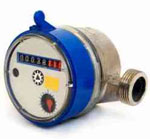
Leading the Way Without Lead
- By Laura Williams
- Jun 14, 2011
Meter madness has taken effect at AWWA’s Annual Convention and Expo. “Smart” meters that monitor usage at high resolution and are programmed to send a signal to utilities in the event of unusual water usage (which typically indicates leaks) are all over the showroom floor, and the capabilities they bring to water use analysis are far-reaching.
In addition to the smart meter refrain, there is a chorus of “no lead, no moving parts at the expo. It seems companies in every corner are trying to get ahead of the provisions of the Reduction of Lead in Drinking Water Act that take effect in the early days of 2014. The law will prohibit the use of any lead in surfaces that touch drinking water, including the ubiquitous brass.
Foundries incorporate lead in brass fixtures because the element makes it easier for foundries to machine parts, according to Michael Rothberg, territory manager at A.Y. McDonald Manufacturing Company, which manufactures a variety of brass waterworks products.
Meter manufacturers in particular are taking diverging paths in the face of this regulatory requirement to forego lead.
Some, such as Sensus and Elster, are largely abandoning brass, opting instead for a composite or stainless steel construction for the meter. Through the efforts of materials engineering, some polymer composites can bear up to twice the pressure brass can. However, Rothberg said that polymer and stainless constructions are not as versatile as brass, in that they cannot be formed into as many types of fittings.
McDonald and other companies with a history in foundering the alloy are sticking with brass and substituting bismuth, an element commonly used in cosmetics, medicines, and medical procedures, for the lead. Rothberg said that the switch in material will change the properties of the brass, making the machining process a bit more difficult. Nonetheless, he said that orders for no-lead brass are up, and his company is pouring the material twice a month.
And then there’s a hybrid solution: A composite interior with lead-containing brass threads fitted on top. Thomas Gwynn, president of Elster Water Inc., explained that his company decided to go this route to help ease the transition from brass to polymer, as well as to reduce the risk of stripped or crossed threads, a phenomenon associated with plastic threading.
Mike Tracy of Sensus, which sticks to 100-percent composite meters in its Aquastream system, was somewhat skeptical that the combination of materials would work well. “I think it’s all about fashion, to be honest,” he said. “What concerns me is that you’re sticking these meters outside, in the ground sometimes, and the composite and the metal will expand and contract at different rates.”
About the Author
Laura Williams is a content editor for Environmental Protection. She can be reached at [email protected].